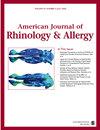急性围手术期微粒物质暴露对内窥镜鼻窦手术结果的影响:多地点初步调查
IF 2.5
3区 医学
Q1 OTORHINOLARYNGOLOGY
引用次数: 0
摘要
背景据推测,环境暴露在慢性鼻炎(CRS)的病理生理学中起着重要作用。目的 确定急性、围手术期暴露于可吸入颗粒物对内窥镜鼻窦手术(ESS)后疗效的影响。方法 前瞻性地招募了自行选择ESS的CRS患者。记录了22个项目的中国鼻腔结果测试(SNOT-22)和医疗结果研究问卷短表6-D(SF-6D)的健康效用值。根据居住地的邮政编码,利用环境保护局空气质量监测仪的数据,对患者手术当月接触 PM2.5 μm 和 PM10 μm 的情况进行了二次分析。斯皮尔曼相关系数 (ρ)、95% 置信区间 (CI) 和效应估计值 (β) 被用来确定相关性的大小。结果 来自美国四家地理位置独特的医疗机构的 107 名患者接受了 6 个月的随访。通过单变量分析(ρ = 0.26, 95% CI: 0.08, 0.43; P = .01)和经协变量调整后的多变量分析(B = 1.06, 95% CI: 0.001, 2.14, P = .05),围手术期PM2.5暴露量较高的患者与暴露量较低的患者相比,ESS术后SNOT-22评分改善较少。与SF-6D结果或作为相关暴露的PM10没有发现类似的关联。围手术期的 PM 水平与术后 Lund-Kennedy 内窥镜检查评分之间没有发现明显的相关性。要证实本研究结果的临床意义,还需要进行更大规模、基于人群、更标准化的 PM 暴露窗口研究。本文章由计算机程序翻译,如有差异,请以英文原文为准。
The Impact of Acute Peri-operative Particulate Matter Exposure on Endoscopic Sinus Surgery Outcomes: A Preliminary Multi-site Investigation
BackgroundEnvironmental exposures have been postulated to play an important role in the pathophysiology of chronic rhinosinusitis (CRS). Particulate matter (PM) is one of the most widely studied ambient air pollutants, but its peri-operative impact on CRS is unknown.ObjectiveTo determine the effect of acute, peri-operative PM exposure on outcomes after endoscopic sinus surgery (ESS).MethodsParticipants with CRS who self-selected ESS were prospectively enrolled. The 22-item SinoNasal Outcome Test (SNOT-22) and Medical Outcomes Study Questionnaire Short-Form 6-D (SF-6D) health utility values scores were recorded. Using residence zip codes, a secondary analysis of patient exposure to PM <2.5 μm and <10 μm (PM2.5 and PM10, respectively) was performed for the month of surgery utilizing data from Environmental Protection Agency air quality monitors. Spearman's correlation coefficients (ρ), 95% confidence intervals (CIs), and effect estimates (β) were used to determine the magnitudes of association. Simple, multivariate regression analysis was also completed.ResultsOne hundred and seven patients from four geographically unique institutions across the US were enrolled with a follow-up of 6 months. Patients with higher peri-operative PM2.5 exposure had less improvement in their SNOT-22 scores after ESS compared to those with less exposure using both univariate analysis (ρ = 0.26, 95% CI: 0.08, 0.43; P = .01) and after covariate adjustment with multivariate analysis ( B = 1.06, 95% CI: 0.001, 2.14, P = .05). Similar associations were not found with SF-6D outcomes or with PM10 as an exposure of interest. No significant correlations were found between peri-operative PM levels and Lund-Kennedy endoscopy scores post-operatively.ConclusionPreliminary data from this pilot study reveal that PM exposure at the time of ESS may negatively associate with post-operative improvement in sinonasal quality-of-life. Larger, population-based studies with more standardized PM exposure windows are needed to confirm the clinical significance of the present findings.
求助全文
通过发布文献求助,成功后即可免费获取论文全文。
去求助
来源期刊
CiteScore
5.60
自引率
11.50%
发文量
82
审稿时长
4-8 weeks
期刊介绍:
The American Journal of Rhinology & Allergy is a peer-reviewed, scientific publication committed to expanding knowledge and publishing the best clinical and basic research within the fields of Rhinology & Allergy. Its focus is to publish information which contributes to improved quality of care for patients with nasal and sinus disorders. Its primary readership consists of otolaryngologists, allergists, and plastic surgeons. Published material includes peer-reviewed original research, clinical trials, and review articles.

 求助内容:
求助内容: 应助结果提醒方式:
应助结果提醒方式:


